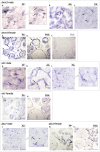Sex determination in the Squalius alburnoides complex: an initial characterization of sex cascade elements in the context of a hybrid polyploid genome
- PMID: 19636439
- PMCID: PMC2713423
- DOI: 10.1371/journal.pone.0006401
Sex determination in the Squalius alburnoides complex: an initial characterization of sex cascade elements in the context of a hybrid polyploid genome
Abstract
Background: Sex determination processes vary widely among different vertebrate taxa, but no group offers as much diversity for the study of the evolution of sex determination as teleost fish. However, the knowledge about sex determination gene cascades is scarce in this species-rich group and further difficulties arise when considering hybrid fish taxa, in which mechanisms exhibited by parental species are often disrupted. Even though hybridisation is frequent among teleosts, gene based approaches on sex determination have seldom been conducted in hybrid fish. The hybrid polyploid complex of Squalius alburnoides was used as a model to address this question.
Methodology/principal findings: We have initiated the isolation and characterization of regulatory elements (dmrt1, wt1, dax1 and figla) potentially involved in sex determination in S. alburnoides and in the parental species S. pyrenaicus and analysed their expression patterns by in situ hybridisation. In adults, an overall conservation in the cellular localization of the gene transcripts was observed between the hybrids and parental species. Some novel features emerged, such as dmrt1 expression in adult ovaries, and the non-dimorphic expression of figla, an ovarian marker in other species, in gonads of both sexes in S. alburnoides and S. pyrenaicus. The potential contribution of each gene to the sex determination process was assessed based on the timing and location of expression. Dmrt1 and wt1 transcripts were found at early stages of male development in S. alburnoides and are most likely implicated in the process of gonad development.
Conclusions/significance: For the first time in the study of this hybrid complex, it was possible to directly compare the gene expression patterns between the bisexual parental species and the various hybrid forms, for an extended set of genes. The contribution of these genes to gonad integrity maintenance and functionality is apparently unaltered in the hybrids, suggesting that no abrupt shifts in gene expression occurred as a result of hybridisation.
Conflict of interest statement
Figures






Similar articles
-
Expression pattern of anti-Müllerian hormone (amh) in the hybrid fish complex of Squalius alburnoides.Gene. 2008 Mar 15;410(2):249-58. doi: 10.1016/j.gene.2007.12.018. Epub 2008 Jan 2. Gene. 2008. PMID: 18242010
-
Polymorphism of major ribosomal gene chromosomal sites (NOR-phenotypes) in the hybridogenetic fish Squalius alburnoides complex (Cyprinidae) assessed through crossing experiments.Genetica. 2004 Nov;122(3):291-302. doi: 10.1007/s10709-004-1420-1. Genetica. 2004. PMID: 15609552
-
Gene expression regulation and lineage evolution: the North and South tale of the hybrid polyploid Squalius alburnoides complex.Proc Biol Sci. 2010 Nov 22;277(1699):3519-25. doi: 10.1098/rspb.2010.1071. Epub 2010 Jun 16. Proc Biol Sci. 2010. PMID: 20554543 Free PMC article.
-
Natural pathways towards polyploidy in animals: the Squalius alburnoides fish complex as a model system to study genome size and genome reorganization in polyploids.Cytogenet Genome Res. 2013;140(2-4):97-116. doi: 10.1159/000351729. Epub 2013 Jun 18. Cytogenet Genome Res. 2013. PMID: 23796598 Review.
-
Evolution in action through hybridisation and polyploidy in an Iberian freshwater fish: a genetic review.Genetica. 2001;111(1-3):375-85. doi: 10.1023/a:1013783029921. Genetica. 2001. PMID: 11841181 Review.
Cited by
-
Transcriptome sequencing and de novo annotation of the critically endangered Adriatic sturgeon.BMC Genomics. 2013 Jun 18;14:407. doi: 10.1186/1471-2164-14-407. BMC Genomics. 2013. PMID: 23773438 Free PMC article.
-
A polymorphic microsatellite from the Squalius alburnoides complex (Osteichthyes, Cyprinidae) cloned by serendipity can be useful in genetic analysis of polyploids.Genet Mol Biol. 2011 Jul;34(3):524-8. doi: 10.1590/S1415-47572011005000023. Epub 2011 Jul 1. Genet Mol Biol. 2011. PMID: 21931529 Free PMC article.
-
Global analysis of the small RNA transcriptome in different ploidies and genomic combinations of a vertebrate complex--the Squalius alburnoides.PLoS One. 2012;7(7):e41158. doi: 10.1371/journal.pone.0041158. Epub 2012 Jul 18. PLoS One. 2012. PMID: 22815952 Free PMC article.
-
Sex determination in annual fishes: Searching for the master sex-determining gene in Austrolebias charrua (Cyprinodontiformes, Rivulidae).Genet Mol Biol. 2014 Jun;37(2):364-74. doi: 10.1590/s1415-47572014005000009. Genet Mol Biol. 2014. PMID: 25071401 Free PMC article.
-
The evolutionary history of the allopolyploid Squalius alburnoides (Cyprinidae) complex in the northern Iberian Peninsula.Heredity (Edinb). 2011 Jan;106(1):100-12. doi: 10.1038/hdy.2010.70. Epub 2010 Jun 9. Heredity (Edinb). 2011. PMID: 20531449 Free PMC article.
References
-
- Baroiller JF. Endocrine and environmental aspects of sex differentiation in fish. Cellular and Molecular Life Sciences. 1999;55:910–931.
-
- Devlin RH, Nagahama Y. Sex determination and sex differentiation in fish: an overview of genetic, physiological, and environmental influences. Aquaculture. 2002;208:191–364.
-
- Schartl M. A comparative view on sex determination in medaka. Mech Dev. 2004;121:639–645. - PubMed
-
- Otto SP, Whitton J. Polyploid incidence and evolution. Annu Rev Genet. 2000;34:401–437. - PubMed
Publication types
MeSH terms
LinkOut - more resources
Full Text Sources
Molecular Biology Databases

